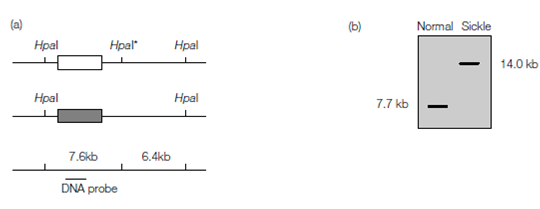Restriction fragment length polymorphisms:
Analysis of human genomic DNA has revealed in which there are several differences in DNA sequence among individuals which have no general effect, frequently because the changes lie in introns or among genes. Some of these modifications are very general in individuals in a population and are known as polymorphisms. Several polymorphisms affect the size of fragments produced through a particular restriction enzyme, for instance through changing a nucleotide in the recognition sequence and so eliminating a cut site. Alternatively of two restriction fragments being produced from this region, a single huge restriction fragment is now built that is shown in the above figure. In the other words the polymorphism should result from the insertion or deletion of

Figure: Analysis of human genetic disease using RFLPs. The analysis concerns two individuals from a family, one of whom has normal -globin and one of whom has an abnormal
-globin gene that leads to sickle-cell anemia. (a) The sickle -globin is associated with a nucleotide change that results in the loss of the HpaI site marked with an asterisk. The presence or absence of this HpaI* site is detected by hybridization and Southern blotting (see Topic I3) using a DNA probe for the 7.6 kb fragment; (b) normal DNA with three HpaI sites yields a 7.6 kb fragment detected by the DNA probe but sickle DNA yields a 14.0 kb fragment due to loss of the HpaI* site.
Sequences among two cut sites so increasing or decreasing the size of which restriction fragment produced. A polymorphism which affects restriction fragment sizes is known as a RFLP (restriction fragment length polymorphism). To providing that a DNA probe exists for a sequence of DNA within the affected region, so that this sequence can be detected through hybridization, RFLPs can be detected through Southern blotting.
The price of RFLPs has been in the ability to use these as markers for particular human genetic diseases. Let's suppose a polymorphism which happens to be very near to the site of modifies in a key gene which results in a human genetic disease. Because these two changes, the polymorphism and the genetic defect, lie close together on the similar chromosome, they will tend to be co-inherited. Identifying like a closely linked restriction fragment length polymorphism has two main benefits. First one is, experiments can be directed to cloning DNA near the restriction fragment length polymorphism in the hope of identifying the gene itself that can then be sequenced and studied. Secondly is, even in the absence of the gene, the restriction fragment length polymorphism acts as a screening marker for the disease; individuals who have the RFLP have a large possibility of having the related gene defect. Of course other RFLPs that are located a very long way from the gene, or even on a variant chromosome, will essentially be unlinked instance for because of the high probability of cross-over events during meiosis to produce germ-line cells the gene and restriction fragment length polymorphism will have only a 50:50 chance of being co-inherited. Therefore a huge amount of very painstaking work has to be carried out to recognize a useful restriction fragment length polymorphism for a particular human genetic disease. Huge numbers of individuals in family groups, some of whom suffer from the disease, required to be screened for a range of likely RFLPs to attempt to locate an restriction fragment length polymorphism that is routinely co-inherited with the gene defect.
As the genes themselves are identified and sequenced, so the need for restriction fragment length polymorphism markers declines since specific DNA probes for the most common types of gene defect can be employed. Additionally, the use of the polymerase chain reaction in screening for human genetic disease is increasingly the techniques of choice rather than restriction fragment length polymorphism analysis because it is much faster to perform and needs far less clinical material for analysis.